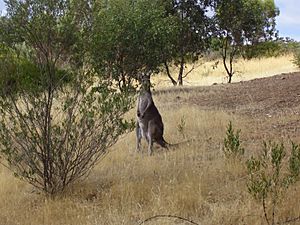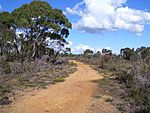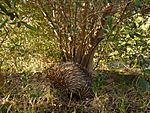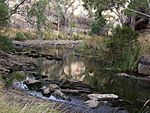Onkaparinga River National Park facts for kids
Quick facts for kids Onkaparinga River National ParkSouth Australia |
|
|---|---|
|
IUCN Category II (National Park)
|
|
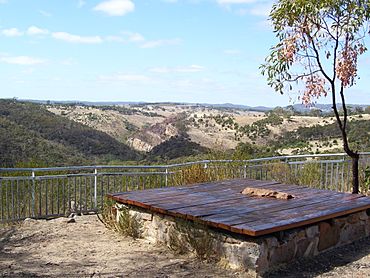
Sundews lookout
|
|
| Nearest town or city | Adelaide city centre |
| Established | 5 August 1993 |
| Area | 15.42 km2 (6.0 sq mi) |
| Managing authorities | Department for Environment and Water |
| Website | Onkaparinga River National Park |
| See also | Protected areas of South Australia |
Onkaparinga River National Park is a special protected area in South Australia, a state in Australia. It's located about 32 kilometers (20 miles) south of the main city, Adelaide city centre. This park covers the low-lying land near the Onkaparinga River, east of Main South Road. It's a great place to explore nature and learn about the local environment.
Contents
History of Onkaparinga Park
Most of the land that makes up Onkaparinga River National Park was bought by the South Australian government between 1973 and 1977. The main reasons for buying this land were:
- To create open spaces for people to enjoy and relax.
- To protect the natural beauty of the area, including its native plants and animals.
- To act as a natural barrier between city areas and farmland.
In 1982, the land was given to the Department for Environment and Heritage. They created the Onkaparinga River Recreation Park in 1985. Later, in 1993, the part of the park east of Main South Road (known as the 'gorge section') became the Onkaparinga River National Park. Both the recreation park and the national park are now managed together as the 'Onkaparinga River Reserve'.
Who Lived Here Before?
The lower parts of the Onkaparinga River were originally home to the Kaurna Aboriginal people. The name of the river, Onkaparinga, comes from a Kaurna word meaning 'chief'. European settlers and farmers began arriving in the area around 1840. This led to the Kaurna people being quickly moved from their traditional lands. However, the Kaurna people still have strong connections to this area through their culture and beliefs. The town of Noarlunga, now called Old Noarlunga, was a central place for farmers. They would transport their produce about 10 kilometers (6 miles) down the river to Port Noarlunga.
Plants and Animals of the Park
The plants in Onkaparinga River National Park have been changed a lot by human activities over time. However, some original patches of vegetation still remain. The best preserved area is called Hardy's Scrub. For 160 years, activities like livestock grazing, cutting down trees, and farming have removed many native plants from the park's undergrowth. Now, many areas are mostly covered by invasive grasses.
The most noticeable native trees are the eucalypts. You can find different types here, including Eucalyptus microcarpa (grey box), Eucalyptus fasciculosa (pink gum), Eucalyptus porosa (mallee box), Eucalyptus camaldulensis (red gum), and Eucalyptus leucoxylon (blue gum).
The European olive (Olea europaea) is a harmful weed in South Australia. It has spread into the park. While these olive trees are not as big as those in older parks like Belair National Park, they are still a problem that needs to be managed.
Over the last twenty years, people have worked hard to replant native species in the gorge area. At first, they planted young eucalypt trees. More recently, they have used a method called 'direct seeding'. This is where seeds of native plants are plowed into a specially prepared trench.
You can also spot many insects in the park, like butterflies (Lepidoptera) and dragonflies (Anisoptera). Kangaroos are very common on the open hillsides where there is plenty of grass for them to eat.
Explore the Trails
Onkaparinga River National Park has several exciting trails for you to explore. Each trail offers a unique way to see the park's beauty.
Hardys Scrub Hike
This hike is a 4-kilometer (2.5-mile) loop and takes about 2 hours. You can start it from Gate 11. Hardy's Scrub is a very important area for nature. Even though it has been used for timber cutting, quarrying, and grazing in the past, it still has valuable native plants.
Nature Hike
This trail is a 3.5-kilometer (2.2-mile) loop and takes about 2 hours. You can start from Gate 6. The Nature Hike gives you great views of the gorge. As you walk, you might see many different kinds of birds and even a lizard or two!
Echidna Hike
This loop trail is 3.5 kilometers (2.2 miles) long and takes about 2.5 hours. It starts from Gate 7. The Echidna Trail winds through some of the best remaining native plants. You'll also visit six old heritage sites, including huts and houses built in the 1880s. The main trees here are peppermint box, with river red gum in the valleys and pink gum on the higher slopes. Other plants include sheoak, golden wattle, and small groups of native pine trees. Twenty-seven different types of native orchids have also been found in this area!
Sundews Ridge Hike
This is a 4-kilometer (2.5-mile) loop that takes about 2 hours. You can start from Gate 6. It's a fairly short hike that leads you to the Sundews Lookout. From there, you can see amazing views of the rocky cliffs and the winding Onkaparinga River below.
Gorge Track
This is a challenging 3.5-kilometer (2.2-mile) return trail that takes about 4 hours. You start from Gate 18. This tough trail takes you to high points overlooking the gorge. Then, it goes steeply down to the river.
Sundews River Hike
This 4-kilometer (2.5-mile) loop takes about 4 hours. It starts from Gate 6. This rocky trail goes steeply down from the Sundews Lookout to the bottom of the gorge. It then follows the river for a short distance before climbing back up the steep slopes of the gorge to the ridge and then to the car park.
Rock Climbing Adventures
If you're interested in rock climbing, it's allowed in a special cliff area near Gate 10. However, you need to have specific climbing skills and the right equipment. It's also important to contact the Belair District Office first before you plan your climb.
Images for kids
See also
 In Spanish: Parque nacional Río Onkaparinga para niños
In Spanish: Parque nacional Río Onkaparinga para niños



